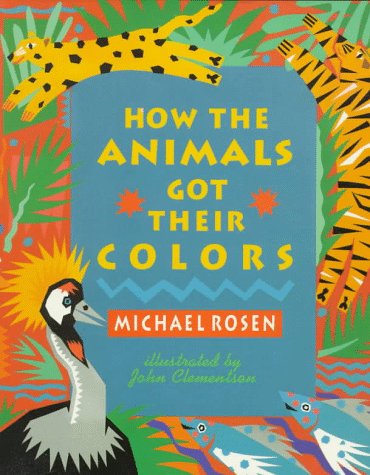

 |

|

The average rating for How the animals got their colors based on 2 reviews is 2.5 stars.
Review # 1 was written on 2017-12-29 00:00:00 Matthew Laramore Matthew LaramoreThis was an interesting collection of animal tales collected from around the world that explains how particular animals came to look the way they are. As such it is a mixture of cultures with no actual true focus. Unfortunately there is no real organization to the stories nor is there at first glance any actual way to tell where the stories come from. Fortunately for readers who do want to know there is a small collection at the back that does provide more cultural information even if it just is a broad covering and some brief info on the main animal. The book is full of cultural-type illustrations thus they are bright, busy and full of details for one who may be interested. All in all it was a good collection but not one of the best out there. |
Review # 2 was written on 2015-10-14 00:00:00 Minh Tran Minh TranTitle: How The Animals Got Their Colors Author: Michael Rosen Illustrator: John Clementson Genre: Myth, Folklore Themes: Animals, Uniqueness Opening line/sentence: Coyote is a wild dog. He thinks he's so cunning, so clever. Brief Book Summary: Using old myths and folktale stories passed down from long ago, Rosen explains how eight different animals got their colors and explains why they are the way they are today. He talks about how has the leopard always had black spots, what turned the dancing brolga bird gray, where did the coyote get his yellow eyes, why peacock's markings resemble teardrops, and so on. Professional Recommendation/Review #1: Carolyn Phelan (Booklist) Rosen retells nine animal tales from around the world, including an African story explaining how the leopard got its spots, a native American pourquoi tale of how the coyote got its yellow eyes, and a Greek myth explaining why frogs are green on their backs and white on their bellies. Vibrant paper-cut collages fill the pages with diverse patterns and contrasting colors. Despite their cluttered appearance, many of the illustrations have a vitality of line and a rhythmic repetition of form that make them effective. Appended notes on the tales include information about the people who told them and the animals themselves. In a pleasing decorative touch, each description in the notes is accompanied by a striking depiction of the animal, drawn from the illustrations but isolated on the blue-bordered, white pages. First published in England, this is a possible source for storytelling or reading aloud. Professional Recommendation/Review #2: Kirkus Nine pourquoi stories drawn from named sources such as Bulfinch, The Journal of American Folklore, and the work of various anthropologists. Rosen's retellings are spare but fairly lively; Clementson's illustrations, vibrant with sharp- edged areas of joyful intense color that appear to have been cut with scissors, dramatically frame the stark white areas of the text. Concluding notes about cultural sources and the animals themselves are addressed to young readers; it's too bad that the credited sources are not also mentioned. An outstandingly handsome, eye- catching book- one that's likely to be especially useful to storytellers and teachers. Response to Two Professional Reviews: Both reviewers mainly talk about how well done and bright the illustrations are. However, I do agree with the first review that the pictures are a bit clustered and overwhelming for the eyes of a young child. By making the pictures less overwhelming, they would be more effective for young learners. Evaluation of Literary Elements: This book is extremely colorful with lots of bright colors and animals but has a lot going on. This could distract the readers attention and draw their eye away from the story. The style of the book is in rhythmic repetitions, which makes catchy and more fun for readers. The language is written in a simple, accessible way. However, they book has a lot of words per page so it might be tricky for some readers to follow along. The main conflict in each story is explaining to the reader how an animal got a specific characteristic. Consideration of Instructional Application: This book can be used to talk to first through fourth graders about myths and folklore. After reading the story, students will create their own animal folklore. Students could pick any animal of their choice (one not from the book) and use construction paper to create their animal. Next, students will pick a trait (color, tail, etc) from their animal depending on their grade level, they will write anywhere from a short paragraph to an essay explaining how their animal that trait. |
CAN'T FIND WHAT YOU'RE LOOKING FOR? CLICK HERE!!!